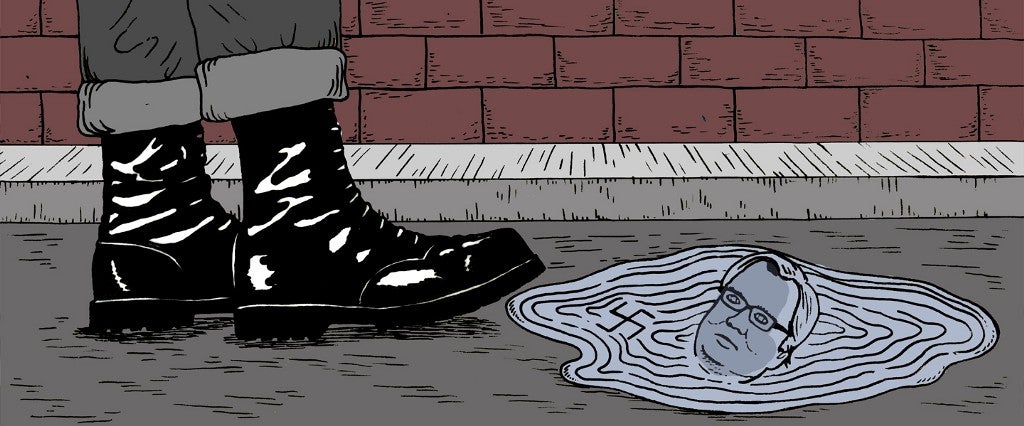Five years ago, in Berlin, I was walking along a strange cobblestoned half-street criss-crossed by bike paths that was exactly the kind of street many Americans probably associate with Europe: poorly designed, public in an aggressive sort of way, probably funded by high taxes and useful to almost no one.
I was chuckling to myself about the wacky differences between Europe and the U.S. when I looked up and saw a poster of a mustachioed man on a motorcycle. “Gas geben!” proclaimed the poster, or, in English: “Give it gas!” The poster was sponsored by Germany’s NPD, a neo-Nazi political party I’d heard about but not given much thought. To be clear, the “gas” referred to gas chambers, as in, “bring gas chambers back to Germany.”
I’d never seen a Holocaust “joke” aired so publicly outside of the Sarah Silverman Show or Curb Your Enthusiasm. The differences between the U.S. and Germany, in that moment, seemed less “wacky” and more chilling.
Later, I’d see Berliners wearing the neo-Nazi brand Thor Steiner — which seems to have borrowed its graphic design department from Ed Hardy — on my subway ride to work. Throughout my four-and-a-half year stint in Berlin, I’d discover that German racism was blatant. It didn’t hide behind Twitter avatars; it marched in leather boots in the center of Berlin’s busiest shopping districts.
Today, though, I wouldn’t be shocked to see the Holocaust joked about in a poster on an American street. This election has numbed me to the twisted methods anti-Semites use to get reactions out of Jews, often on Twitter. Scroll through the mentions of the average Jewish journalist’s account and you’ll be treated to lots of “lulz” about ovens, the “Arbeit Macht Frei” gates and other Holocaust tropes. It’s a cesspool that has made me feel unsafe in America for the first time in my life.
Now, in the midst of a resurgence of hate crimes — more than 300 have been reported since election day, according to the Southern Poverty Law Center, roughly the amount usually reported in five or six months — Donald Trump has anointed the former publisher of Breitbart as his new chief White House strategist. It looks like the same racists who’ve terrorized Jewish writers online will now have a surrogate within spitting distance of the Oval Office.
Bannon is a violent, homophobic misogynist accused of having beaten his wife. He believes that progressivism is nothing more than a philosophy of victimhood. Breitbart, the site he led for more than four years, regularly posts articles with charming headlines like “Would You Rather Your Child Had Feminism or Cancer?” “Bill Kristol: Republican Spoiler, Renegade Jew,” and “Birth Control Makes Women Unattractive and Crazy.” Bannon’s ex-wife has testified that he “doesn’t like Jews” and didn’t want his children to go to school with them.
The man who will be in Trump’s White House IRL also proudly declared Breitbart a “platform for the alt-right” and maintains close ties with the populist white nationalist movement. Ben Shapiro, a writer for Breitbart who resigned after a reporter for the site was forcibly grabbed by Trump’s then-campaign manager Corey Lewandowski, later wrote that the alt-right movement championed by Breitbart was “shot through with racism and anti-Semitism.”
In the aftermath of Bannon’s appointment, I was reminded how I felt in Berlin when a sense of security I’d taken for granted suddenly evaporated.
In Germany, I was able to take an iota of comfort in the country’s centrist governing coalition and the existence of the “antifa,” or anti-fascists, who vastly outnumber neo-Nazis and would organize counter-rallies when right-wing skinheads dared to march on the streets in the middle of Berlin. Germany also has NGOs, like Exit Germany, dedicated to helping neo-Nazis who decide they want to leave the subculture. In 2011, the group distributed souvenir t-shirts emblazoned with pro-nationalist text at a white pride rock concert; when washed, the shirts revealed an anti-fascist message offering assistance in escaping the neo-Nazi scene.
Combating the radicalization of young Germans is also a priority of Germany’s domestic intelligence agency. When the most populous state, North-Rhine Westphalia, saw a surge of attacks on refugee homes, the government — not a privately funded organization like the Southern Poverty Law Center — reported on it. There’s an awareness that neo Nazi communities can provide a sense of belonging to the disaffected, and that fighting them requires playful and subversive tactics, like tricking a neo-Nazi group into raising thousands for an anti-extremist organization.
Of course, Germany still has many dark forces with which to contend. German hipster neo-Nazis, or nipsters, are still a thing, and even launched a “vegan cooking channel” on YouTube to attract new members. The German refugee crisis has also led to the ascension of groups like Alternative für Deutschland, led by a woman whom many see as a German Donald Trump. Merkel, under scrutiny from all corners of the country, is still a powerful defender of liberalism in Europe — but she is “tired,” according to associates of hers who spoke with The New York Times.
But it’s hard not to think that we’re much more doomed. Unlike Germany, we don’t have the luxury of a federal agency that monitors right-wing extremism. We don’t have organizations that give radicalized young white men an exit strategy. Instead, we have an ethno-nationalist in our White House. With the appointment of Bannon, Trump has explicitly endorsed the ethos of white supremacy. (That’s, I guess, how he will “unite our country.”)
The only answer is to hound Republicans on the rise of online white supremacy the way they hound Democrats on the rise of radical Islam in the West. We should force them to respond to the anti-Semitism, racism and ethno-nationalism that have propelled Steve Bannon to a White House role. We should also contact our representatives — via old-fashioned telephone, so they’ll be forced to listen — and tell them to denounce Bannon and the white supremacist horse he rode in on.
